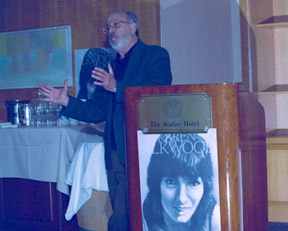
Crash
V
Had someone really tried to kill Mazzocchi to keep the Silkwood story buried? No one knows (or is telling). Stranger plots were rumored in the 1970s. In 1975, The Washington Post 's Bob Woodward reported that the Watergate special prosecutor's office was investigating a bizarre plan by E. Howard Hunt, a Nixon operative, to kill columnist Jack Anderson after he had published sensitive national security information. According to the article, “Hunt said one plan involved placing on the steering wheel of Anderson's car a substance that would enter the body through skin contact.” Hunt had allegedly been looking for, and may have found, “a drug that would take effect when Anderson was driving home at high speed . . .”
Mazzocchi readily admitted that he had no evidence that he had been drugged before his accident. He had his suspicions, but saw no point in pursuing what would look like a narcissistic conspiracy theory. It was enough that he survived the wreck and was able to keep the Silkwood story alive.
One day more than a year after the accident, Susan Mazzocchi was packing up the house in preparation for a move. As she removed a clock from the kitchen wall, something fell to the floor and broke apart.
“It's a bug!” she exclaimed to Tony. “I was looking for a roach to smash,” Mazzocchi said. But what Susan had found was the other kind of bug .
Mazzocchi's ally (and Silkwood family attorney) Danny Sheehan took the find to a contact who worked for the CIA. “He called it ‘the most sophisticated bugging device,'” said Mazzocchi. “It was sending a radio signal that somebody was picking up, maybe blocks away from the house.”
Were the spying, the accident, and Silkwood connected? Sheehan tried to trace the bug through dark alleys of the surveillance underworld. He gave the device (still broken from its fall from the kitchen wall) to David Waters, a former CIA electronics expert. Reportedly, when Waters saw it he just smiled, and in less that a minute had the two-inch-long, three-quarterinch-wide device back together again. Then he asked Sheehan, “What are you doing that the NSA is so interested in?”
 The suggestion that the National Security Agency was involved in the bugging of Mazzocchi's house seemed extravagant. But someone had been listening, and Tony always believed it was someone with an interest in thwarting a serious investigation of the Silkwood case—someone who feared its impact on the huge financial potential of nuclear power. The suggestion that the National Security Agency was involved in the bugging of Mazzocchi's house seemed extravagant. But someone had been listening, and Tony always believed it was someone with an interest in thwarting a serious investigation of the Silkwood case—someone who feared its impact on the huge financial potential of nuclear power.
Through their dogged efforts, Mazzocchi and activists around the country had ensured that Karen Silkwood's sacrifice would never be forgotten.
Now, in looking ahead, Mazzocchi looked up. If he was ever going to liberate OCAW from the business unionists, the CIA, and the atomic establishment, he needed more authority. Mazzocchi wanted to become president of his union.
Karen Silkwood would have welcomed that.
Picture: Tony Mazzocchi, assistant to the executive vice president of Paper, Allied-Industrial, Chemical and Energy Workers International Union (PACE), speaks at the "Commemoration of a Critical Struggle -- Karen Silkwood in Retrospect," April 26 in the Statler Hotel's Terrace Lounge. Mazzocchi was a colleague of Silkwood's. Barry DeLibero/University Photography
First | Page 2 3 4 5 |